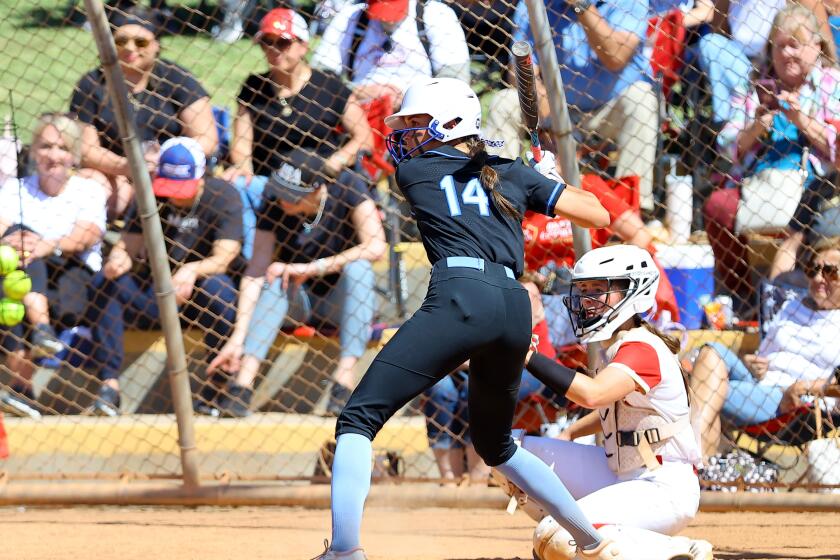Pitch for a Safer Baseball Isn’t a Strike Against the Game
- Share via
What I need right now, if there were such a thing, is a serious Top Ten list from David Letterman. No gags, no inside jokes, nothing risque.
The category is, “Top Ten Things Parents Ask Their Kids After a Little League Game.”
Wouldn’t it go something like this:
10. Did you win?
9. Did you get any hits?
8. Did you have any chances in the field?
7. Did you get to play the whole game?
6. Who played well for your team?
5. Was the other team good?
4. What was the most exciting play in the game?
3. Do you feel like you’re improving?
2. How many hot dogs did you eat after the game?
And the No. 1 Thing Parents Ask Their Kids After a Little League Game:
DID YOU HAVE FUN?
You can probably come up with a more imaginative list, but isn’t the idea of Little League to give the kids some exercise, while teaching them about winning and losing? And, most of all, isn’t it supposed to be about the kids HAVING FUN?
It seems so simple, and yet Little League games remain the single best argument against letting people carry sidearms in public. There would be sandlot carnage across America that would make urban streets look like the Garden of Eden.
The latest flap is in Laguna Niguel, where some parents are pushing for a baseball that’s a little softer than the classic ball. They want something called the “reduced injury factor” ball, which is the same size as a regular ball but which absorbs impact better.
Some Little Leagues around the country use the so-called RIF ball, but the Rancho Niguel Little League has balked, using it for the youngest age groups, but not for kids 7 and older. The league’s argument has been that Little League injuries are rare and that the traditional baseball is, well, part of the game’s storied history--just like aluminum bats.
For those of you who know Little League, this dispute sounds familiar, doesn’t it? Aren’t you figuring that it’s just the latest power struggle between parents and Little League officials, who tend to get along like the Hatfields and McCoys? Yeah, me too. Whatever the argument, each side historically accuses the other of taking the fun out of the game. My research has shown that in every 100 cases, each side is right about 50 times.
As with most Little League disputes, disinterested observers are never quite sure whether to chuckle or recoil. But someone has to win this one, so I may as well settle the whole darn thing.
For starters, I’m in the front row of hidebound traditionalists, especially when it comes to baseball. But are we really robbing 10-year-olds of tradition by using a safer, softer baseball? Is there something inherently Norman Rockwellian about getting your teeth knocked out by a bad-hop grounder?
It’s not like someone is calling for replacing second base or changing the rules so that two people can occupy a base at the same time, although that has long been a Little League staple. All the insurgent parents seem to be asking for is that the league err on the side of caution.
I’ve applied my historical perspective to this problem. To wit, my greatest memory of Little League was my fear of getting plunked in the ol’ bean. I don’t think my enjoyment of the game would have been seriously undercut by a kinder and gentler horsehide.
In an odd way, perhaps it takes a non-parent like myself to explain some things to real parents. Such as, your kid may not want to confess he or she’s afraid of the ball. Maybe, just maybe, his or her enjoyment of the game would be increased with a softer ball.
There will be plenty of time in later life (say, when they’re about 13 or so) to appreciate the thwack of bat on ball. Until then, what’s the big deal about a safer ball?
My guess, and here I go being cynical again, is that certain parents already start thinking of their kids as future major leaguers and, by God, they can’t afford to let the kid off to a slow start by using a phony ball.
From what I’ve read, there are differing opinions about the worthiness of the RIF ball. If even one 10-year-old every 20 or 30 years gets seriously injured or killed by a baseball, would it really have been worth it?
If the new ball significantly changed the game, I’d vote to veto it. But for 12 and under, the game is about much, much more than the sound of the bat on the ball.
Unfortunately, that’s the hardest part of the game for some adults to master.
Dana Parsons’ column appears Wednesday, Friday and Sunday.
More to Read
Go beyond the scoreboard
Get the latest on L.A.'s teams in the daily Sports Report newsletter.
You may occasionally receive promotional content from the Los Angeles Times.










